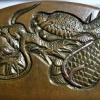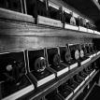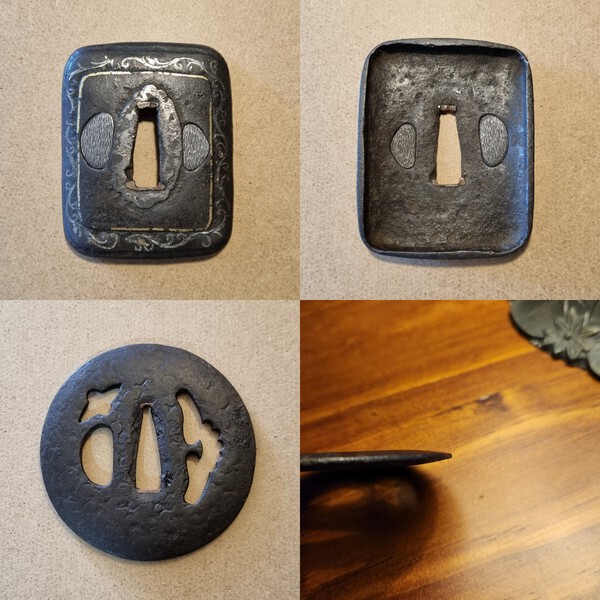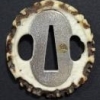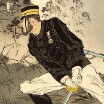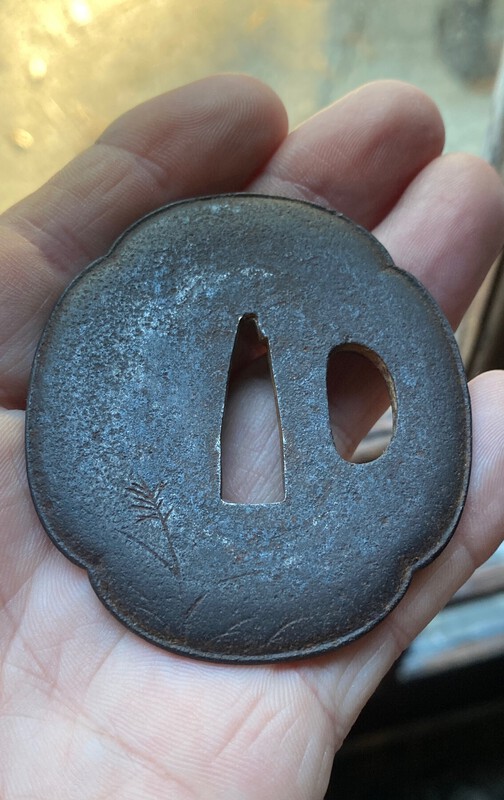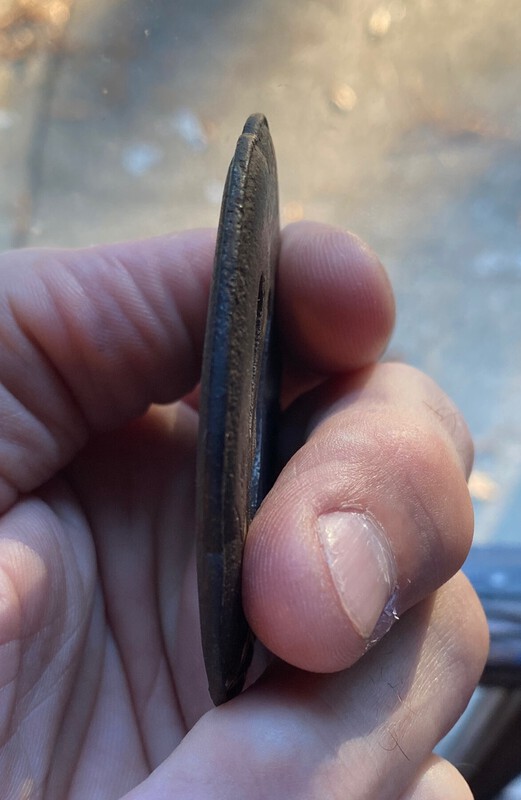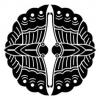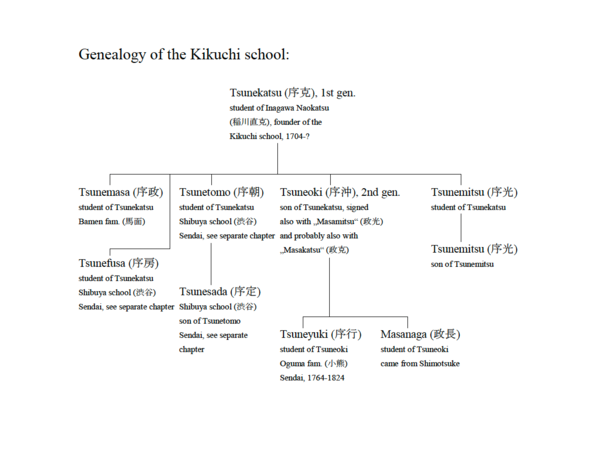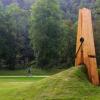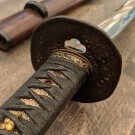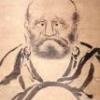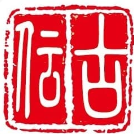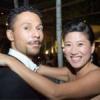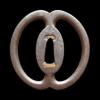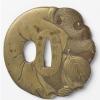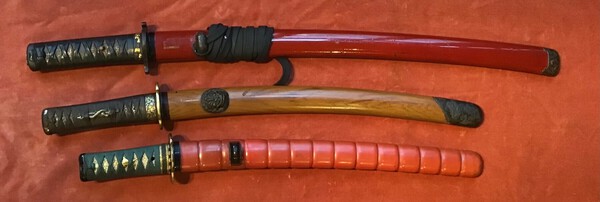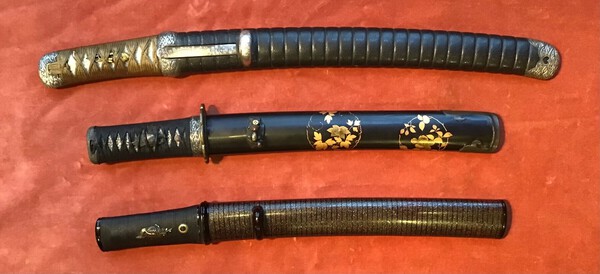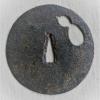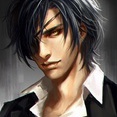Leaderboard
Popular Content
Showing content with the highest reputation on 11/17/2024 in all areas
-
7 points
-
So, out of my collection of about 150 tsuba only a very (very) few are in a concave or convex shape. I figure for a master tsuba maker to forge that type of shape probably took a lot of extra work! Why was that concave or convex shape done? Was it to distribute the weight of the tsuba differently on the blade? Less weight towards the blade and more weight away from the blade for a concave shape. More weight towards the blade and less weight away from the blade for a convex shape. Or was it just an artistic choice by the craftsman? Anyway, I have included pictures of one of my concave and convex shape tsuba. When I purchased these tsuba I had no idea of their concave or convex shape, since no pictures showing that shape of the tsuba were shown and the seller did not describe the shape in his listing. Only when I received the tsuba and hefted them and placed my fingers over them, did I become aware of the concave or convex shape of the tsuba. I think it would be interesting if members could post pictures of what they have! Onward!4 points
-
4 points
-
Looks to be an early style field grade tassel, is the rest of the sword nice?3 points
-
3 points
-
2 points
-
My notes: Tsuba doesn't have the clear definition as in genuine Japanese shin-gunto parts. The flowers in all the parts look different than shin gunto cherry blossoms. Holes for the locking mechanism in tsuba and seppa are badly defined and made in different way that I've seen in any shin-gunto. Pommel doesn't look right in any shape or form. Knot loop and tassel are clearly recent production.2 points
-
2 points
-
Jake, I don’t think the first tsuba which you posted (from Aoi Art) is linked to the Kikuchi school, there is no artist listed with that name, and the style isn’t in keeping with the Kikuchi school, who specialised in katakiribori. In my opinion, it’s a Mito school tsuba with a fictitious mei. The second tsuba which you posted is by Kikuchi Tsunekatsu, the founder of the Kikuchi school. I had a quick look at the meikan and the kao looks good to me. Here’s some information about him from Sesko’s Signatures of Japanese Sword Fitting Artists: 24.1 Kikuchi Tsunekatsu (菊池序克), 1st gen. The founder of the Kikuchi school was Tsunekatsu, a student of Inagawa Naokatsu (稲川直克). He also received the character for „Katsu“ from the latter. He was born in the first year of Hōei (1704) and was called „Seijirō“ (清次郎). Because of his artistic background in the Inagawa school he worked mostly in shakudō with nanako ground and takabori-iroe ornamentations but his strong point was katakiribori. In his later years he entered priesthood and took the nyūdō-gō „Sōju“ (宗寿). Other pseudonyms of Tsunekatsu were „Sōryūken“ (草流軒) and „Gidōken“ (蟻洞軒). There are also works extant which are signed with the characters (常克) for „Tsunekatsu“ and it is assumed that they go back to his earlier years. In addition, we know a joint work (gassaku, 合作) with Naoharu (柳川直春, 1750-?), the 3rd gen. Yanagawa, which is signed with the supplement „made at the age of 60“. That means Tsunekatsu was also in direct contact with the Yanagawa school. His year of death is unknown but the latest extant information about his age mentions „made at the age of 64“. That means he was at least active until the Meiwa (1764-1772) era.2 points
-
Don't wish to keep this going but I just received an email from Imazu-san ........ Dear Valued Customer, I sincerely apologize for the inconvenience caused by my poor health. Thanks to you, I am now feeling much better. We will resume normal business operations from tomorrow. We will also resume shipments to overseas customers, which have been delayed. We deeply apologize for any concern and inconvenience caused, and we ask for your understanding and forgiveness. We look forward to your continued support of Giheya. Sincerely, Imazu Atsuogi Hiraya2 points
-
George everything I can see in the bad pics suggests it is WW2 sword. The tassel does look original and well used as does the Ito. The chuso buttons are often replaced as they are easily broken by the uninitiated. That replacement could be wartime or post. Pierced tsuba and central chuso hole on fuchi are typical signs of Type 94 but Kabuto-gane maybe not...but that's nothing. As for the blade ? .... need better pics, particularly of nakago and kissaki.2 points
-
何-- 姿の小野ハ秋-- 在?の淋しき風の音すれ Not quite enough to get it, but some allusion to the "Aname" nozarashi theme mentioned in the thread below? I'm not sure about the bits in red. I'm taking a leap with these, but given the theme and the reference to Ono (Ono no Komachi, I think), its leading me to think it is talking about the apocryphal story of Ariwara Narihira finding the skull of his former lover Ono no Komachi in a field.2 points
-
2 points
-
Hi Dave, It looks like some of your pictures are not coming through. This sword will undoubtedly spark some discussion. Some swords with this tang stamp have been posted here before, here is one example, here is another. The fittings also fall into a known pattern, see also here, and here. There is evidence that various patterns of crude Japanese-style swords were made in China, Java, and other places outside of Japan during the war for Japanese or collaborator forces. There is also evidence that fake Japanese swords were made during and immediately after the war (and ever since) by enterprising individuals to sell as souvenirs to GIs. Without provenance or conformity to one of the known "patterns," it's hard to tell the difference between the two. Search for threads on "island swords."2 points
-
Ohmura has a picture of a Tenshōzan 天照山 dirk. http://ohmura-study.net/741.html2 points
-
Interesting, your tsuba seems a lot more similar stylistically to the first example... As you said, not much similarity to mine. I did find these examples of Kozuka by "Kikuchi Tsunesada", circa 1800 that has a similar design and style to my tsuba (shishi lion/tiger, katakiribori) Now I don't know what to think! Are these two different branches of the Kikuchi lineage?2 points
-
So I have been doing some research into different schools and I came upon an interesting tsuba from the kikuchi school. I was wondering if anyone had any additional information about the Kikuchi school artisans/lineage as I am curious about the particular artisan who created this piece. I am particularly interested in knowing if this is an example of musume-bori from a female artisan. Any help would be appreciated. https://www.aoijapan...sui/#google_vignette1 point
-
Nice job on the high resolution photos, @Lewis B. They show a lot of detail.1 point
-
@dwmc great spot! But that one's on me, I actually mirrored the image to help me notice anything odd. Thanks for all the thoughts everyone, much appreciated! I'm hoping I can buy this one 🤞1 point
-
Thanks John! I'm learning more each time I post. I'll try the talcum powder later today.1 point
-
1 point
-
Hi Deanna, The swirl effect is called mokume gane and is a product of folding the metal as used in the manufacture of sword blades but it's not a process confined to any one group or school of makers so it's hard to kantei it based on that alone, however, this type of tsuba are quite desireable and I think you've got an attractive piece there. You could try sprinkling a little talcum powder over the signature to see if that highlights any of the strokes, but without something to make it a little clearer it's too vague for me.1 point
-
Hi Derek, no, would just leave it alone. As mentioned above, its observable. I didn't mean it was a disaster or anything, just that the polish looks like it could be better. Many blades out there that have a polish that could be better. Some dealers known to take short cuts and cut costs with polishing blades, as well as owners.1 point
-
Dear Nicolas, IMO, and it's a personal thinking that can be discussed : to date, Michael Sabatier's working has nothing to do here, and that's not a quality matter. He honestly says it himself on his website and on interviews, he's not making things as the Japanese traditional way, he say himself "being in margin" and assume that. He is autodidact and never learned traditional techniques. He may be amazingly good, he's not doing more Nihonto than Chinese makers of katana. Nihonto collectors are not searching for a tool, a toy or a decorative object, they collect essence of antique art in an object that "embodied" the ancient tradition inherited by the craftsman, generations after generations. That said it seems to be a very talented guy, doing well lots of things.1 point
-
Thanks all. Appreciate it. Yes..I do suspect it had the 2 Kai Gunto o-seppa at some point. I guess I'll be looking out for a set and see if I can get them to SA. Rest of the fittings look original. I would guess that Masahiro was a workshop more than just a single smith. Maybe a number of workers making swords in a workshop and being signed by him. If it's true that he had a workshop at Takayama prison, then likely that prisoners were making swords under his direction and maybe they were signed by him. Resemblance to Emura's efforts, but more mass produced and not Gendaito. Sword was part of a larger deal for knives and militaria, and will be able to sell the other stuff for more, so it's essentially at no cost. Can't beat that price1 point
-
1 point
-
Should be Kikuchi Masahira (菊地正平) but there is no such smith listed in Wakayama's index. There are two Masahiras, but neither of them use the name Kikuchi. One is a Shōami artist, and the other uses the gō of Tetsugendō. So I'm a bit skeptical of the name. The inscription/poem also eludes me 骨---無---波---誰と too many blanks that need filling in, but some musing on bones, as you can guess just by looking at the theme without knowing any of the characters. I don't know if that orphaned bit of writing on the right side is part of the poem, or if it is something else (name of the poet, for example).1 point
-
I have seen a small number of officer gunto with a screw/bolt. Seems like it would be a post-war addition to a sword missing the mekugi. But no way to know.1 point
-
This does have the appearance that suggests war kaigunto. At first, I was thinking something custom, but I can't say I've ever seen any without the daiseppa that weren't late war. The large seki stamp has been seen as late as 1944, so it's feasible. Masahiro must have been a prolific smith. I have 26 of his blades on file.1 point
-
Signed Kanetsune and appears to be a Sue-seki (late Muromachi Mino) blade.1 point
-
dont be lead astray but uneducated words, everything show in these pictures is just modern repro s**t, full stop the end. its not Japanese, its not evan pre 1980's. you have failed to educate yourself with books before buying. thats not a gamble its being uneducated1 point
-
Wow, Stephen! Super cool! Thanks for the illiustrations, information, and pictures! With respect, Dan1 point
-
Feels ok. Its probably an average shinto, but everything seems to be observable, so its not too bad of a polish.1 point
-
1 point
-
I think your hunch is correct that the o-seppa are missing and that someone added seppa to tighten the sword up. The thick seppa do not appear to be sized for this sword. The rest of the rig looks nice with decent rayskin and strict navy-style hiramaki wrap with the knot on top. I think you did well for very, very cheap. You should be able to find a pair of o-seppa without much difficulty.1 point
-
According to the document, it became clear that the red characters are 長井 - Nagai.1 point
-
1 point
-
1 point
-
Hello all. I will be continuing to offer items from my collection at the next Birmingham Arms Fair. As I have said before, I am not a dealer and am selling purely to return to collecting Meiji Artworks. This Arms Fair is my sole outlet but I’m always happy to meet up elsewhere if necessary. Obviously more relevant to UK residents. All will be priced to sell and they include a sumptuously mounted Tachi, finely mounted Tanto, Wakizashi and Aikuchi plus many tsuba, menuki and kozuka etc. Most blades are in good original Japanese polish, some with papers. None have been messed around with! I will add more detailed descriptions in a few days but for now…… All the best. Colin1 point
-
Benjamin, you cannot increase the density of a metal with mechanical methods. The density of steel is always 7,85, and very small variation would only be possible by using special alloying metals like tungsten or cobalt. In theory, large quantities of a lighter metal like titanium would make the steel less dense, but that would show only in the last figures. Just to mention it, intense hammering does not make the steel harder....1 point
-
1 point
-
1 point
-
1 point
-
Do not find the missons art gifts for prussia, .. but we have these gifts in France. I will try to find out more about this poor wakizashi. https://www.japanpol...082920221811409.html1 point
-
Experimenting with my new macro lens and cheap IKEA LED lighting this evening and got some nice images of the Jie formations on the Senjuin. I had to downsize the images to get them to upload onto NMB, but at native resolution they look great. Amazing how effective a $5 LED light can be. I have added the high rez versions of the images here, and a few others, to my Google Drive gallery. https://drive.google...j-eZWYtgSKfamVWFUlsO1 point
-
1 point
-
1 point
-
I would agree with Jacques that I don't think it is utsuri. However I cannot explain what it is or what creates an effect like this. However it is nice looking sword in overall. 😊1 point
This leaderboard is set to Johannesburg/GMT+02:00

